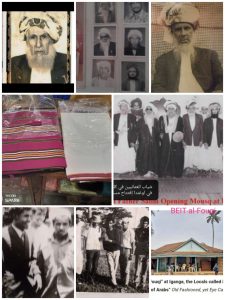KAMPALA/MUSCAT. One of the good friends of Uganda, Mohamed Nasser al Sinawi al Harthi, 68 has authored a friendship book that details the legacy of his countrymen.
He has called for the United Nations Educational, Scientific and Cultural Organization (UNESCO) to document and store the story officially.

Mohamed Nasser al-sinawi al-harthi’s book UNDERSTANDING UGANDA’S HISTORIC RELATIONSHIP WITH THE SULTANATE OF OMAN, SINCE 1844AD, launched this year he lays facts about the friendship of the Sultanate of Oman and the people of Uganda 178 years ago. The book is on the market.
Mr. Mohamed was brought up and raised in different places in Busoga District in Uganda.
Mohamed heaps praise on Uganda, the Pearl of Africa, describing the country as hospitable, beautiful and into which his descendants settled peacefully.
However, all that relationship is visible, there was no official diplomatic relationship till recently, the Omani consulate was opened.
Mr. Mohamed descends from his grandfather Ammar bin Mreshid who arrived and married in Buganda in 1870, but later in life he moved to Uganda’s Eastern District of Iganga in Busoga region. The wellness and hospitality of the attracted Ammar’s cousin Mohamed bin Rshed Rshud al- Sinawi who also decided to settle at Iganga in 1885.
Mr. Mohamed’s descendants endured hardships traveling to the East African Coast at Mombasa or Zanzibar using small boats called Dhows from Oman via Aden in Yemen and Kismayu in Somali. The Omanis then traveled from Mombasa by foot into Uganda a distance of 1200km.
“The Omanis in Uganda became well known by the locals and other Foreigners. They made Uganda to become a focal point for foreigners traveling deep inside Africa and to and fro the East African Coast” Mr. Mohamed says in his book- currently the precious treasure of his origin’s legacy.
In Iganga where Mr. Mohamed’s descendants lived, they left a Unique House called the “Beit al-Fouqi”, which until now, locals call the “House of Arabs.” It was built and owned by an Omani, Mohamed bin Rshed bin Rshud al-sinawi al-harthi before 1900.
“Beit al-Fouqi is probably the Oldest House in Iganga, once a landmark and a focal for Omanis, Arabs and other Foreigners traveling to and fro African Continent and East African Coast. It is Old Fashioned, yet the house is still Intact and Eye Catching.
Mohamed, the author grew up in different parts of Busoga, Uganda where he settled with his family which was rooted in agriculture and trade.
Mohamed studied in Uganda but later went for further studies to Bahrain and UK and graduated as a Telecommunications Engineer.
In his book, Mohamed examines how through the stay of Omanis in Uganda his country’s culture was embedded with the indigenous Ugandans especially by the dressing code among Ugandans.
‘’The Original Omani dishdasha with Shakht locally known in Uganda as ‘Ekanzu’s Yo Mulera and Busuuti- are very popular outfits among Ugandans, they came from Omanis.
When the Kabaka accepted Islam, he became the first person to put on the Omani Dasha- the Kanzu with the Mrera and Bisuti. He was followed by his senior officials and subordinates,’’ Mohamed writes.
He says acceptance of Islam into Uganda by the Kabaka was the first official mark where Uganda’s friendship with the Omanis is traced in 1844 AD, a relationship of nearly over 178 years.
‘’The old Original Dishas with shakht locally known as *Ekanzu Yo Mulera* which our grandmothers in Oman and Uganda used to sew by hand are now sewn by tailors all over Uganda.
However, some of our Omanis tailors in Oman have taken the initiative to make the old Omani Dishdasha with Shakt, Mohamed writes on page 26 of his book.
Indeed, in Uganda, kanzus are a great business and many Ugandans are employed tailoring the outfit, like in the areas of Nakasero in Kampala.
The Kanzus designs are now sold in local Ugandan Market as soverniers to tourists.
The Kanzu and Bisht are the official wear during many occasions like marriage introduction events etc.
Did you know that * there are various types of Omani wizra locally known as Bikoyiz in Uganda were manufactured in Different Omani Villages and exported to Uganda before 1900, and the WIZRA *BIKOYIZ* were named according to the Omani village in which it was made, for example, the wizar that was made in the village of Quriyat is called “Karyati”, and from Ibra “Bula”, and from Sumail “Ismaili*”.These names exist to this day, in Uganda especially the elders till 1970s. Some tribesmen use the Bikoyiz as Shukaz
Further in the region, the Lubans, incense burning was brought in and introduced of Omanis.
Mohamed says “we were able to pick up and learn local Ugandan food and cultures and these got us acquainted with all people,” Mohamed says.
In the field of foods-the Omanis learnt and became experts in preparing local foods such as Matooke, mandazi or the bans bread, cassava among other foods.
In the field of business, the newest book by Mohamed it is recorded that Omanis, a group of people who until today are remembered for their honesty, operated wholesale and retail shops, agriculture produce, and operated transport vehicles.
Omanis have participated in uplifting social services in Uganda through improving the health sector, education, constructing improved water sources, and have consistently contributed relief items. They have supported setting up of many Masjids and Water boreholes and Orphanage Homes.
Pictorial











